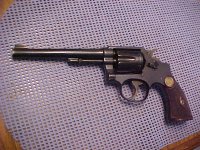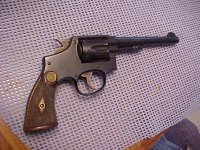Hi Guys
I picked up a super nice S&W 32-20 revolver today at a local gun show. I don't see a model number but I do have the serial number 85238. I was wondering when it was made, possible value and if there is a model number for this gun??
Thanks for any info. Oh it also has two sets of grips, the originals and the others look like fake Ivory ??
John
Bluing is about 90%, bore looks great and cylinder is tight.
I picked up a super nice S&W 32-20 revolver today at a local gun show. I don't see a model number but I do have the serial number 85238. I was wondering when it was made, possible value and if there is a model number for this gun??
Thanks for any info. Oh it also has two sets of grips, the originals and the others look like fake Ivory ??
John
Bluing is about 90%, bore looks great and cylinder is tight.
Attachments
Last edited:


